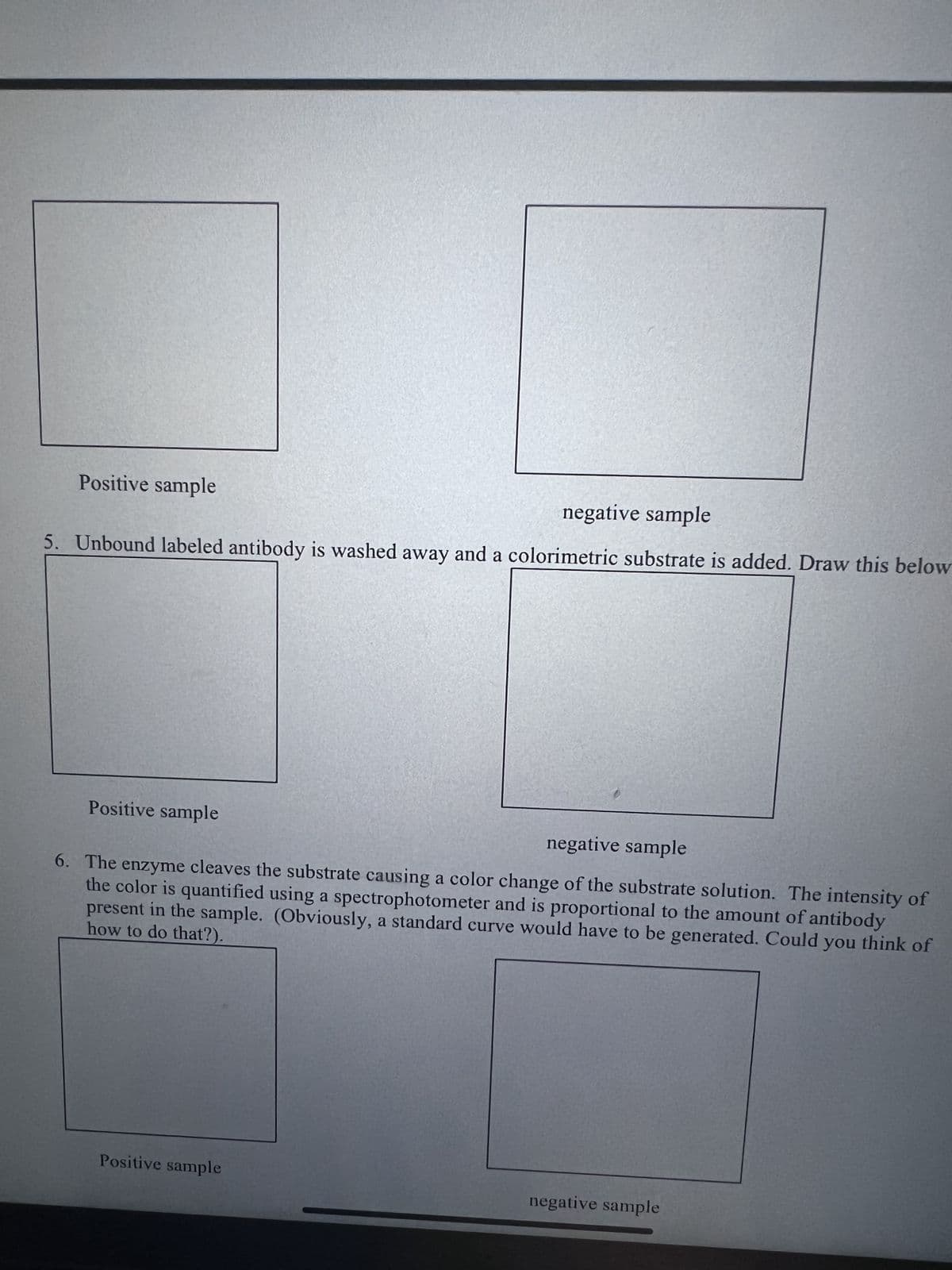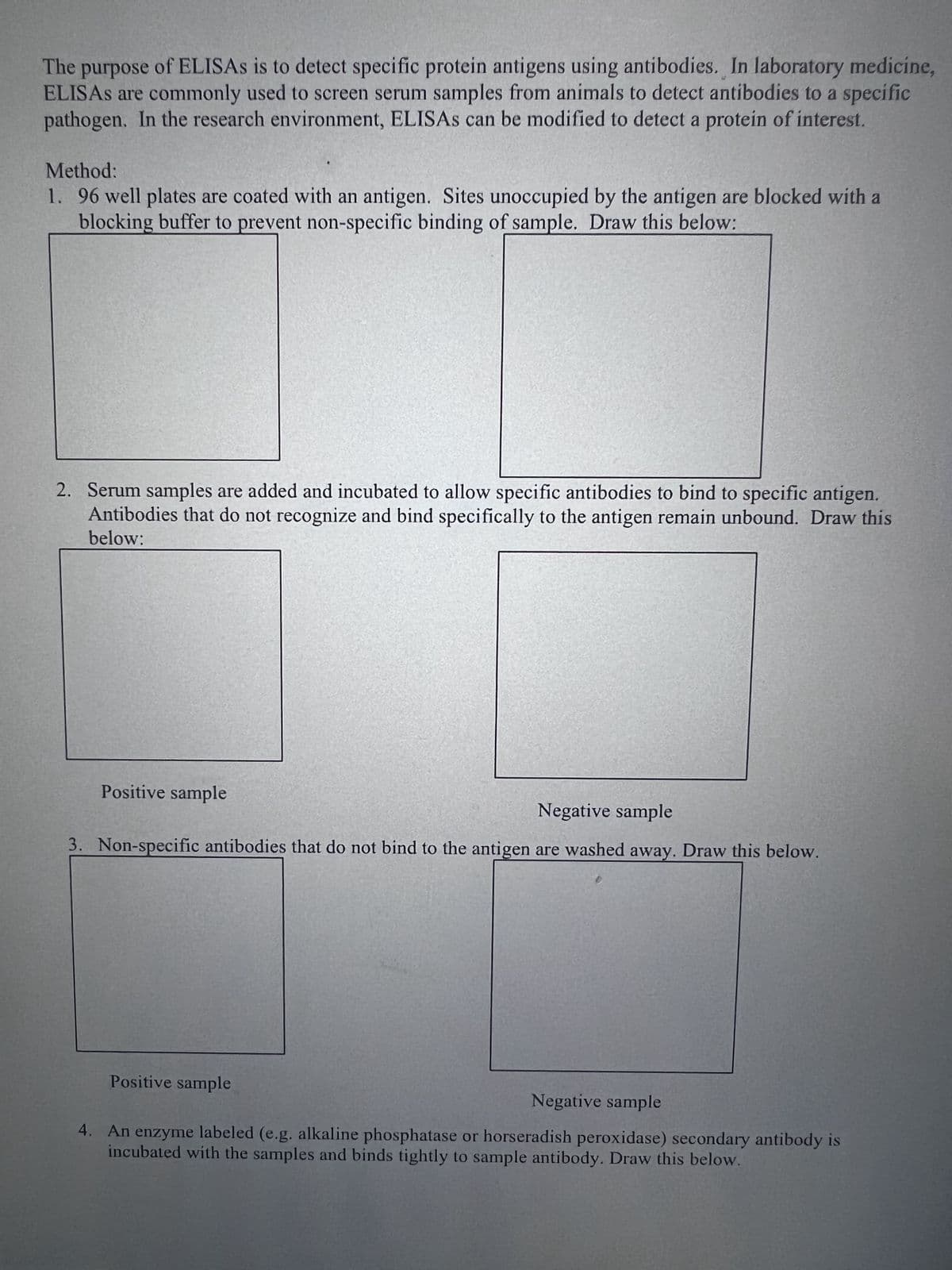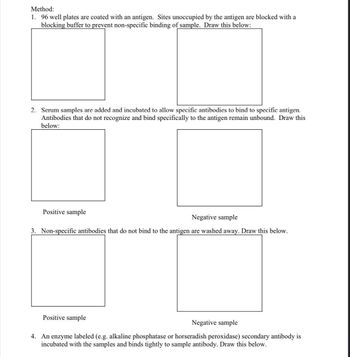Positive sample negative sample 5. Unbound labeled antibody is washed away and a colorimetric substrate is added. Draw this Positive sample negative sample 6. The enzyme cleaves the substrate causing a color change of the substrate solution. The intensity the color is quantified using a spectrophotometer and is proportional to the amount of antibody present in the sample. (Obviously, a standard curve would have to be generated. Could you think how to do that?). Positive sample negative sample
Positive sample negative sample 5. Unbound labeled antibody is washed away and a colorimetric substrate is added. Draw this Positive sample negative sample 6. The enzyme cleaves the substrate causing a color change of the substrate solution. The intensity the color is quantified using a spectrophotometer and is proportional to the amount of antibody present in the sample. (Obviously, a standard curve would have to be generated. Could you think how to do that?). Positive sample negative sample
Human Anatomy & Physiology (11th Edition)
11th Edition
ISBN:9780134580999
Author:Elaine N. Marieb, Katja N. Hoehn
Publisher:Elaine N. Marieb, Katja N. Hoehn
Chapter1: The Human Body: An Orientation
Section: Chapter Questions
Problem 1RQ: The correct sequence of levels forming the structural hierarchy is A. (a) organ, organ system,...
Related questions
Question
100%
Can anyone do second part?

Transcribed Image Text:Positive sample
negative sample
5. Unbound labeled antibody is washed away and a colorimetric substrate is added. Draw this below
Positive sample
negative sample
6. The enzyme cleaves the substrate causing a color change of the substrate solution. The intensity of
the color is quantified using a spectrophotometer and is proportional to the amount of antibody
how to do that?).
present in the sample. (Obviously, a standard curve would have to be generated. Could you think of
Positive sample
negative sample

Transcribed Image Text:The purpose of ELISAS is to detect specific protein antigens using antibodies. In laboratory medicine,
ELISAS are commonly used to screen serum samples from animals to detect antibodies to a specific
pathogen. In the research environment, ELISAS can be modified to detect a protein of interest.
Method:
1. 96 well plates are coated with an antigen. Sites unoccupied by the antigen are blocked with a
blocking buffer to prevent non-specific binding of sample. Draw this below:
2. Serum samples are added and incubated to allow specific antibodies to bind to specific antigen.
Antibodies that do not recognize and bind specifically to the antigen remain unbound. Draw this
below:
Positive sample
Negative sample
3. Non-specific antibodies that do not bind to the antigen are washed away. Draw this below.
Positive sample
Negative sample
4. An enzyme labeled (e.g. alkaline phosphatase or horseradish peroxidase) secondary antibody is
incubated with the samples and binds tightly to sample antibody. Draw this below.
Expert Solution
This question has been solved!
Explore an expertly crafted, step-by-step solution for a thorough understanding of key concepts.
This is a popular solution!
Trending now
This is a popular solution!
Step by step
Solved in 2 steps with 3 images

Follow-up Questions
Read through expert solutions to related follow-up questions below.
Follow-up Question

Transcribed Image Text:Method:
1. 96 well plates are coated with an antigen. Sites unoccupied by the antigen are blocked with a
blocking buffer to prevent non-specific binding of sample. Draw this below:
2. Serum samples are added and incubated to allow specific antibodies to bind to specific antigen.
Antibodies that do not recognize and bind specifically to the antigen remain unbound. Draw this
below:
Positive sample
Negative sample
3. Non-specific antibodies that do not bind to the antigen are washed away. Draw this below.
Positive sample
Negative sample
4. An enzyme labeled (e.g. alkaline phosphatase or horseradish peroxidase) secondary antibody is
incubated with the samples and binds tightly to sample antibody. Draw this below.
Solution
Knowledge Booster
Learn more about
Need a deep-dive on the concept behind this application? Look no further. Learn more about this topic, biology and related others by exploring similar questions and additional content below.Recommended textbooks for you

Human Anatomy & Physiology (11th Edition)
Biology
ISBN:
9780134580999
Author:
Elaine N. Marieb, Katja N. Hoehn
Publisher:
PEARSON

Biology 2e
Biology
ISBN:
9781947172517
Author:
Matthew Douglas, Jung Choi, Mary Ann Clark
Publisher:
OpenStax

Anatomy & Physiology
Biology
ISBN:
9781259398629
Author:
McKinley, Michael P., O'loughlin, Valerie Dean, Bidle, Theresa Stouter
Publisher:
Mcgraw Hill Education,

Human Anatomy & Physiology (11th Edition)
Biology
ISBN:
9780134580999
Author:
Elaine N. Marieb, Katja N. Hoehn
Publisher:
PEARSON

Biology 2e
Biology
ISBN:
9781947172517
Author:
Matthew Douglas, Jung Choi, Mary Ann Clark
Publisher:
OpenStax

Anatomy & Physiology
Biology
ISBN:
9781259398629
Author:
McKinley, Michael P., O'loughlin, Valerie Dean, Bidle, Theresa Stouter
Publisher:
Mcgraw Hill Education,

Molecular Biology of the Cell (Sixth Edition)
Biology
ISBN:
9780815344322
Author:
Bruce Alberts, Alexander D. Johnson, Julian Lewis, David Morgan, Martin Raff, Keith Roberts, Peter Walter
Publisher:
W. W. Norton & Company

Laboratory Manual For Human Anatomy & Physiology
Biology
ISBN:
9781260159363
Author:
Martin, Terry R., Prentice-craver, Cynthia
Publisher:
McGraw-Hill Publishing Co.

Inquiry Into Life (16th Edition)
Biology
ISBN:
9781260231700
Author:
Sylvia S. Mader, Michael Windelspecht
Publisher:
McGraw Hill Education